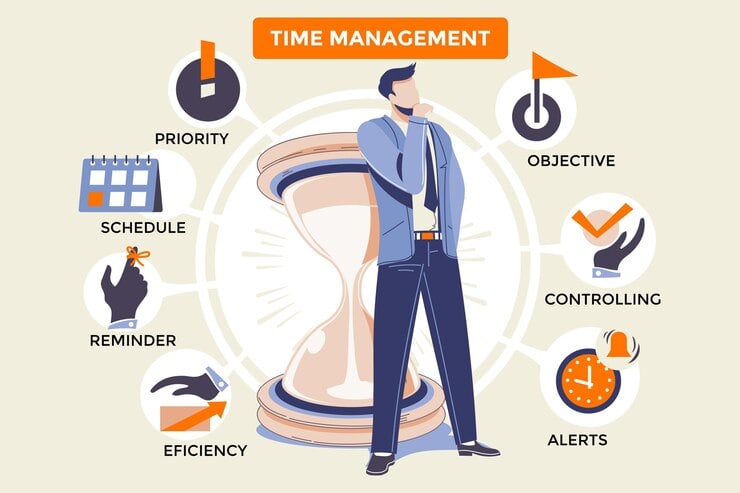Last updated on March 7, 2024 at 10:28 am
As the global population of deskless workers continues to rise, effective employee time management has become increasingly crucial for maintaining a productive workforce. These individuals, dispersed across various fields, undertake indispensable tasks in our society. However, due to the inherent nature of their roles, deskless workers often grapple with a spectrum of time management challenges, including unpredictable work schedules and external factors such as adverse climate conditions.
The absence of proficient time management skills among these workers has consequential effects on their output and elevates stress levels. In this blog, we delve into a detailed exploration of time management strategies tailored for deskless workers, aiming to offer insights on how to support them in becoming more efficient time managers.
7 Time Management Strategies
Let’s explore some of the best time management strategies for deskless workers:
1. Planning and Prioritization
One can improve their ability to manage time and become more proficient by effectively using David Allen’s getting things done (GTD) concept. You can use time blockers, scheduling software, or to-do lists to help you prioritize your tasks and complete them in the allocated time. Every step of the planning process ensures that relevant action plans are prepared in case an unanticipated incident makes it impossible to finish the initial task. Whether you work in an office setting or from home, GTD ensures that all of the work on your to-do list is completed, providing you with the peace of mind to focus on more crucial duties.
Furthermore, deskless employees must differentiate between urgent and important tasks. Hence, devoting time to the appropriate tasks will yield greater outcomes with less effort. For greater results, you can utilize the Eisenhower Matrix as an additional task management tool to arrange and rank tasks according to their importance and urgency.
2. Mastering Your Flow
Distractions, like social media and non-work-related phone calls, are an inevitable part of the workplace. However, if they aren’t managed, they could result in decreased output and poor quality of work from employees. Successful time management strategies at work can be implemented by forcing yourself to break free from the distracting cycle. Additionally, when you have millions of tasks to complete, it can be difficult to stay focused. Therefore, it is vital to understand your productivity rhythms or when you are most focused. It can be either in the morning or after lunch. Try to complete your important task at that time. To master your workflow, you should also try batching similar tasks together to minimize context switching for getting things down at a time.
Also Read: Internal Communications Metrics to Look Out For in 2024
3. Leveraging Technology
Leveraging technology, such as using mobile apps for managing time and maintaining notes or task reminders, can help deskless employees manage their time effectively. Further, automating routine tasks is one of the best time management strategies for deskless employees. By doing so, time that would otherwise be spent manually creating such tasks will be saved. Using technology can also help deskless employees stay connected with colleagues through collaboration platforms. This will help improve productivity and get the job done faster.
4. Maintaining Work-Life Balance
In their dynamic roles, deskless employees often face the challenge of unpredictable work schedules and external factors. By prioritizing work-life balance, deskless employees can enhance their overall well-being and job satisfaction. Encouraging clear boundaries between work and personal life, promoting regular breaks, and fostering open communication channels contribute to a healthier equilibrium. Organizations can play a pivotal role by implementing policies that support work-life balance and providing resources that enable deskless employees to manage their time effectively.
Also Read: Whitepaper: Reach Deskless Workforce With This Communications Primer
5. Staying on Track
Setting realistic goals and deadlines provides a clear roadmap for tasks, helping to prioritize and streamline activities. Tracking progress is essential to gauge achievements and identify potential bottlenecks, enabling timely adjustments to plans. Implementing quick self-reflections at intervals allows deskless workers to pinpoint productivity gaps, fostering continuous improvement. This proactive approach not only enhances individual performance but contributes to overall workforce efficiency, ensuring that deskless employees can navigate their dynamic work environments with agility and effectiveness.
Also Read: Leveraging CMS for Enhanced Internal Communication
6. Continual Improvement
Identifying personal time management weaknesses is a crucial first step for deskless employees aiming to enhance their productivity. By self-reflecting and recognizing areas of weakness, individuals can tailor strategies to address specific challenges. Experimenting with different time management approaches is the next key element. Trying out various techniques allows deskless workers to discover what resonates best with their unique work styles and responsibilities. Furthermore, seeking feedback from colleagues and mentors adds another layer of improvement. Input from those who understand the dynamics of the job can provide valuable insights, fostering a collaborative environment for refining time management skills.
Also Read: CMS for Deskless Workforce: Shaping the Future
7. Embracing Flexibility
For deskless employees, embracing flexibility in their schedules is a crucial time management strategy. Recognizing the uncertainties that may arise, such as unexpected breakdowns of equipment, individuals need to maintain an adaptable mindset. Being open to changes and promptly adjusting plans ensures a resilient response to unforeseen events. During periods of downtime, individuals can make productive use of their time by engaging in activities like acquiring new skills or expanding their professional network. This proactive approach not only helps in navigating unexpected challenges but also enhances their overall skill set, contributing to greater success in their work.
Also Read: 6 Ways to Recognize Deskless Employees
Let’s Sum Up
In conclusion, implementing effective time management strategies for deskless employees is essential for maximizing productivity, reducing stress, and fostering a healthier work-life balance. By incorporating techniques such as prioritizing tasks, utilizing technology to streamline processes, and embracing regular breaks, deskless workers can enhance their overall efficiency and job satisfaction. Organizations must recognize the unique challenges faced by deskless employees and provide the necessary support and resources to help them thrive in their roles.
Frequently Asked Questions
1. What role does technology play in time management for deskless workers?
Technology is a crucial ally for deskless employees in managing their time. Utilizing mobile apps, project management tools, and communication platforms helps streamline tasks, facilitate collaboration, and provide real-time updates. Embracing technology enables deskless workers to stay organized and connected, contributing to increased efficiency and productivity.
2. How can organizations support deskless employees in improving their time management skills?
Organizations can support deskless employees by offering training programs on effective time management, providing access to relevant technology tools, and creating a culture that values work-life balance. Offering flexible schedules, recognizing and rewarding time management achievements, and fostering open communication channels contribute to a supportive environment for deskless workers.
3. How can deskless employees prioritize tasks when their work environment is constantly changing?
Deskless employees can prioritize tasks by understanding their job responsibilities, deadlines, and the overall goals of the organization. Creating a daily or weekly task list, identifying urgent and important items, and adapting priorities based on changing circumstances are key strategies for managing tasks effectively in a dynamic work environment.
Subscribe To The theEMPLOYEEapp Newsletter
Comments are closed.




